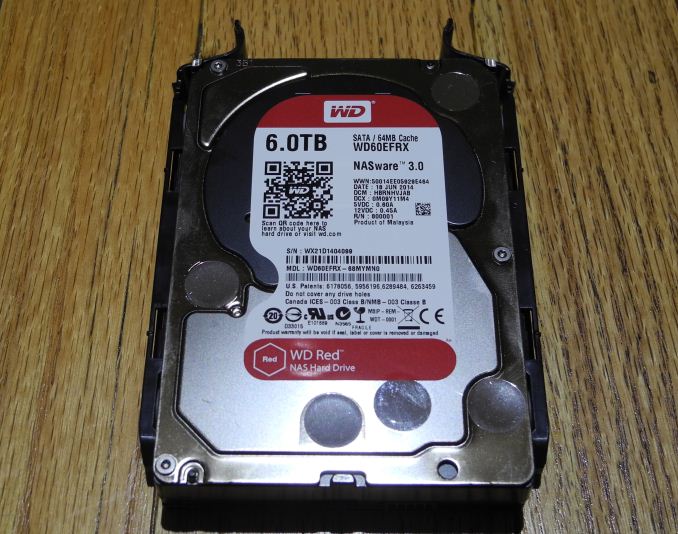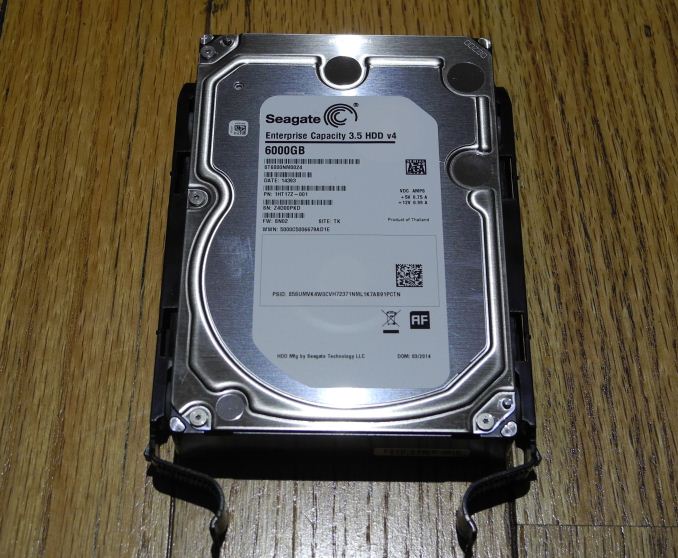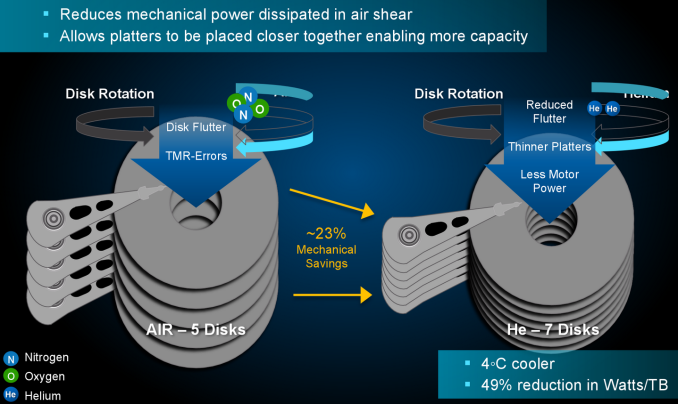6 TB NAS Drives: WD Red, Seagate Enterprise Capacity and HGST Ultrastar He6 Face-Off
by Ganesh T S on July 21, 2014 11:00 AM EST6 TB Face-Off: The Contenders
Prior to getting into the performance evaluation, we will take a look at the special aspects and compare the specifications of the three drives being considered today.
Western Digital Red 6 TB
The 6 TB Red's claim to fame is undoubtedly its areal density. While Seagate went in for a six-platter design for its 6 TB drives, Western Digital has managed to cram in 1.2 TB/platter and deliver a 6 TB drive with the traditional five platter design. The costs are also kept reasonable because of the use of traditional PMR (perpendicular magnetic recording) in these drives.
The 6 TB drive has a suggested retail price of $299, making it the cheapest of all the three drives that we are considering today.
Seagate Enterprise Capacity 3.5 HDD v4 6 TB
Seagate was the first to utilize PMR to deliver a 6 TB enterprise drive earlier this year. They achieved this through the use of a six platters (compared to the traditional five that most hard drives use at the maximum). A downside of using six platters was that the center screw locations on either side got shifted, rendering some drive caddies unable to hold them properly. However, we had no such issues when trying to use the QNAP rackmount's drive caddy with the Seagate drive.
Seagate claims best in class performance, and we will be verifying those claims in the course of this review. Pricing ranges from around $450 on Amazon (third party seller) to $560 on Newegg.
HGST Ultrastar He6 6 TB
The HGST Ultrastar He6 is undoubtedly the most technologically advanced drive that we are evaluating today. There are two main patented innovations behind the Ultrastar He6, HelioSeal and 7Stac. The former refers to placement of the platters in a hermetically sealed enclosure filled with helium instead of air. The latter refers to packaging of seven platters in the same 1" high form factor of traditional 3.5" drives.
With traditional designs, we have seen a maximum of six platters in a standard 3.5" drive. The additional platter is made possible in helium filled drives because the absence of air shear reduces flutter and allows for thinner platters. The motor power needed to achieve the same rotation speeds is also reduced, thereby lowering total power dissipation. The hermetically sealed nature of the drives also allows for immersive cooling solutions (placement of the drives in a non-conducting liquid). This is something not possible in traditional hard drives due to the presence of a breather port.
The TCO (total cost of ownership) is bound to be much lower for the Ultrastar He6 compared to other 6 TB drives when large scale datacenter applications are considered (due to lower power consumption, cooling costs etc.). The main issue, from the perspective of the SOHOs / home consumers, is the absence of a tier-one e-tailer carrying these drives. We do see third party sellers on Amazon supplying these drives for around $470.
Specifications
The various characteristics / paper specifications of the drives under consideration are available in the table below.
| 6 TB NAS Hard Drive Face-Off Contenders | |||
| WD Red | Seagate Enterprice Capacity 3.5" HDD v4 | HGST Ultrastar He6 | |
| Model Number | WD60EFRX | ST6000NM0024 | HUS726060ALA640 |
| Interface | SATA 6 Gbps | SATA 6 Gbps | SATA 6 Gbps |
| Advanced Format (AF) | Yes | Yes | No (512n) |
| Rotational Speed | IntelliPower (5400 rpm) | 7200 rpm | 7200 rpm |
| Cache | 64 MB | 128 MB | 64 MB |
| Rated Load / Unload Cycles | 300K | 600K | 600K |
| Non-Recoverable Read Errors / Bits Read | 1 per 10E14 | 1 per 10E15 | 1 per 10E15 |
| MTBF | 1M | 1.4 M | 2M |
| Rated Workload | ~120 - 150 TB/yr | < 550 TB/yr | < 550 TB/yr |
| Operating Temperature Range | 0 - 70 C | 5 - 60 C | 5 - 60 C |
| Physical Dimensions | 101.85 mm x 147 mm x 26.1 mm. / 680 grams | 101.85 mm x 147 mm x 26.1 mm / 780 grams | 101.6 mm x 147 mm x 26.1 mm / 640 grams |
| Warranty | 3 years | 5 years | 5 years |
The interesting aspects are highlighted above. Most of these are related to the non-enterprise nature of the WD Red. However, two aspects that stand out are the multi-segmented 128 MB cache in the Seagate drive and the HGST He6 drive's lower weight despite having more platters than the other two drives.













83 Comments
View All Comments
NonSequitor - Thursday, July 24, 2014 - link
So something isn't adding up here. I have a set of nine Red 3TB drives in a RAID6. They are scrubbed - a full rebuild - once a month. They have been in service for a year and a half with no drive failures. Since it's RAID6, if one drive returns garbage it will be spotted by the second parity drive. Obviously they can't be returning bad data, or they would have been failed out long ago. The array was previously made of 9 1TB Greens, scrubbed monthly, and over two and a half years I had a total of two drive failures, one hard, one a SMART pre-failure.asmian - Friday, July 25, 2014 - link
Logically, I think this might well be due to the URE masking on these Red drives - something the Green drives weren't doing. You've been lucky that with a non-degraded RAID6 you've always had that second parity drive that has perhaps enabled silent repair by the controller when a URE occurred. I've been pondering more about this and here's what I have just emailed to Ganesh, with whom I've been having a discussion...--------------------
On 24/07/2014 03:45, Ganesh T S wrote:
> Ian,
>
> Irrespective of the way URE needs to be interpreted, the points you
> raise are valid within a certain scope, and I have asked WD for their
> inputs. I will ping Seagate too, since their new NAS HDD models are
> expected to launch in late August.
Thanks. This problem is a lot more complicated than it looks, I think, and than a single URE figure might suggest. But the other "feature" of these Red drives is also extremely concerning to me now. I am a programmer and often think in low-level algorithms, and everything about this URE masking seems wrong in the likely usage scenarios. Please help me with my logic train here - correct me if I'm wrong. Let's assume we have an array of these Red drives. Irrespective of the chance of a URE while the array is rebuilding or in use, let's assume one occurs. You have stated WD's info that the URE is masked and the disk simply returns dummy info for the read.
If you were in a RAID5 and you were rebuilding after you've lost a drive, that MUST mean the array is now silently corrupted, right? The drive has masked the read failure and reported no error, and the RAID controller/software has no way to detect the dummy data. Critically, having a back-up doesn't help if you don't know that you NEED to repair or restore damaged files, and without a warning, due to simple space contraints a good backup will likely be over-written with one that now contains the corrupted data... so all ways round you are screwed. Having a masked URE in this situation is worse than having one reported, as you have no chance to take any remedial action.
If you are in RAID6 and you lost a drive, then you still have a parity check to confirm the stripe data with while rebuilding. But if there's a masked URE and dummy data, then how will the controllers react? I presume they ALWAYS test the stripe data with the remaining parity or parities for consistency... so at that point the controller MUST throw a major rebuild error, right? However, they cannot determine which drive gave the bad data - just that the parity is incorrect - unless it's a parity disc that errored and one parity calculates correctly while the other is wrong. If they knew WHICH disc had UREd then they could easily exclude it from the parity calculation and rebuild that dummy data on the fly with the spare parity, but the masking makes that impossible. The rebuild must fail at this point. At least you have your backups... hopefully.
Obviously the above situation will also be the same for a RAID5 array in normal usage or a degraded RAID6. Checking reads with parity, a masked URE means a failure with no way to recover. If you have an unmasked URE at least the drive controller can exclude the erroring disc for that stripe and just repair data silently using the remaining redundancy, knowing exactly where the error has come from. After all, it's logically just an EXPECTED disk event with a statistically low chance of happening, not necessarily an indication of impending disk failure unless it is happening frequently on the same disc. The only issue will be the astronomically unlikely chance of another URE occurring in the same stripe on another disc.
Fundamentally, a masked URE means you get bad data without any explanation of why a disc is returning it, which gives no information to the user (or to the RAID controller so it can take action or warn the user appropriately). For me, that's catastrophic. It all really depends on what the controllers do when they discover parity errors and UREs in rebuild situations and how robust their recovery algorithms are - an unmasked URE does not NEED to be a rebuild-killer for RAID6, as thank G*d you had a second redundancy disc...
Anyway, the question will be whether these new huge drives will, as you say, accumulate empirical evidence from users that array failures are happening more and more frequently. Without information from reviews like yours that warn against their use in RAID5 (or mirrors) despite the marketing as NAS products, the thought-experiment above suggests the most likely scenario is extremely widespread silent array corruption. I stand by my comment that this URE masking should be a total deal-breaker in considering them for home array usage. Better a disk that at least tells you it's errored.
NonSequitor - Tuesday, July 29, 2014 - link
That still doesn't add up - there are no unmasked UREs in my situation, as I'm using Linux software RAID. It is set to log any errors or reconstructions, and there are literally none. One of these arrays has a dozen scrubs on it now with no read errors whatsoever.m0du1us - Friday, July 25, 2014 - link
@asmian This is why we run 28 disk arrays minimum for SAN. If you really want RAID6 to be reliable, you need A LOT of disks, no matter the size. Larger disks decrease your odds of rebuilding the array, that just means you need more disks. Also, you should never build a RAID6 array with less than 5 disks. At 5 disks, you get no protection from a disk failure during rebuild. At 12 disks, You can have 2 spares and 2 failures during rebuild before loosing data.NonSequitor - Friday, July 25, 2014 - link
Your comment makes no sense. A five disk RAID-6 is N+2. A 28 disk RAID-6 is N+2. More disks will decrease reliability. Our storage vendor advised keeping our N+2 array sizes between 12 and 24 disks, for instance: 12 disks as a minimum before it started impacting performance, 24 disks as a maximum before failure risks started to get too high. Our production experience has borne this out. Bigger arrays are actually treated as sets of smaller arrays.LoneWolf15 - Friday, July 25, 2014 - link
asmian, it totally depends on what you are building the array for, and how you are building it.Myself, I'd use them for home or perhaps small business, but in a RAID 10 or RAID 6. Then I'd have some guaranteed security. That said, if I needed constant write performance (e.g., multiple IP cameras) I'd use WD RE, and if I wanted enterprise level performance, I'd use enterprise drives.
That, and I realize that RAID != backup strategy. I have a RAID-5 at home; but I sure as heck have a backup, too.
tuxRoller - Monday, July 21, 2014 - link
Hi Ganesh,Would you mind listing the max power draw of these drives? That is, how much power is required during spin-up?
WizardMerlin - Tuesday, July 22, 2014 - link
If you're not going to show the results on the same graph then for the love of god don't change the scale of the axis between graphs - makes quick comparison completely impossible.ganeshts - Tuesday, July 22, 2014 - link
I have tried that before and the problem is that once all the drives are on the same scale, then some of them become really difficult to track absolute values across. Been down that road and decided the issues it caused are not worth the effort taken for readers (including me and my colleagues) to glance right and left on the axes side to see what the absolute numbers are.Iketh - Tuesday, July 22, 2014 - link
what? why would they become difficult to "track absolute values" ??